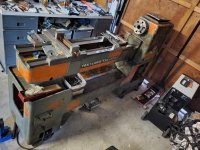arsenix
Plastic
- Joined
- Jul 28, 2011
- Location
- Milpitas, CA
I acquired this machine many months ago and have been picking away at as a project. As with many machines of this age, its first big problem was just an incredible amount of dirt/grime/etc! It appears that it was smacked in the apron by something at some point in its life (handles were bench, carriage gibs cracked), but generally the bed seems to be in great shape and the spindle/gearbox run well.
Here is what I have done to it:
So now I'm assessing the condition of the ways, apron, tailstock. This is where I wondered if folks could chime in. I believe the ways have minimal wear, which I believe is typical for these machines (quality steel, hardened bed ways). I had previously put an indicator based on the carriage, it it looked like the tailstock ways rose about .001" across the full travel. Here is what I've done to assess wear:
So at this point I'm debating what I should do. My goal isn't a perfect restoration, but I'd like it to be tight/accurate as I'll probably have it for a long time once I get it dialed in. It seems clear to me that the base of the carriage is quite worn down (~.02"). I have a mill as well, and could easily set up the apron and machine it down. I could then build it back up with turcite, and scrape it back in using the bed as a reference? Some photos of where she sits right now.





Interested in advice here!
Here is what I have done to it:
- Opened up the headstock, cleaned out old oil/grime. Changed the oil. Replaced drive belts. Spun it up to full speed and it runs nice and quiet with no runout! Win!
- Tore apart the apron/carriage/tailstock. Cleaned up everything for examination. Wiped/scraped/vac'ed the machine including cleaning out an ancient mass of coolant in the reservoir, and scraping off a lot of loose paint. The cross and counter slides certainly have some wear (frosting is mostly worn through).
- Disassembled the apron. Straightened the carriage lever shaft to within .003". Machined a replacement bushing (old had about .005" radial play), and installed into the apron front cover. Straightened the carriage and cross feed levers. Inspected everything in the apron. Replaced the power feed countershaft roller bearings (were dinged up from ingesting chips sitting inside the base of the apron IMHO). Changed all rotary oil seals on the apron.
- Scrubbed and cleaned the ways, carriage.
- Fabricated some heavy steel "feet". Tapped the mounting holes to M20x2. Fabbed some heavy duty leveling screws.
- Leveled the bed to within ~.002", based on the two flat ways (rear carriage way, front tailstock way). Used some 123 blocks on the two flat ways.
So now I'm assessing the condition of the ways, apron, tailstock. This is where I wondered if folks could chime in. I believe the ways have minimal wear, which I believe is typical for these machines (quality steel, hardened bed ways). I had previously put an indicator based on the carriage, it it looked like the tailstock ways rose about .001" across the full travel. Here is what I've done to assess wear:
- Checked level on the cross slide way and carriage top surface (which are very close) while sliding the carriage across the whole bed. The carriage seems to be low at the front (dovetail way) about .02". It does not seem to change much across the travel. Maybe a slight amount, but I'll need to dial in the level even better. I have only been using my "coarse" machinist level so far (.005"/12" per division), but I have a high precision one I can switch too.
- Checked level on the tailstock base while sliding across the bed. It also doesn't seem to change much across the bed (less then my current level/twist tolerance). It seems to be low in the rear (dovetail way) about .002". Not sure this is worth even writing home about!
So at this point I'm debating what I should do. My goal isn't a perfect restoration, but I'd like it to be tight/accurate as I'll probably have it for a long time once I get it dialed in. It seems clear to me that the base of the carriage is quite worn down (~.02"). I have a mill as well, and could easily set up the apron and machine it down. I could then build it back up with turcite, and scrape it back in using the bed as a reference? Some photos of where she sits right now.





Interested in advice here!




